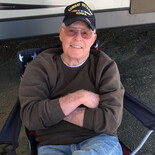David Rheinhart: Korean War Veteran
Local Heroes
January 2, 2021
This is the fifth article in a continuing series about local military veterans and their service to our great country.
As always we begin at the beginning: Dave was born on April 7, 1931 in Indianapolis, Indiana. Sadly, his father "disappeared" when Dave was a small child: "To this day, I still stay in touch with my father's family, but he passed away in his 50s a long time ago." Dave's mother never remarried but went to night school and became a bookkeeper.
Dave attended public schools in Indianapolis. As a teenager, he attended Arsenal Technical High School (a former Civil War military arsenal), focusing on drafting (several advanced students at the high school worked with the state of Indiana helping to design bridges). He worked his way through high school with the Ziv Steel and Wire Company: "I literally learned the steel business in the four years I worked for them." After graduation in 1950, he drove his mother to Southern California so she could live with other family members. In California, while looking for work, Dave often passed the Navy and Marine Corps recruiting station. One day he thought to himself, "I think I'll join up!" So he did, enlisting in the Navy.
The Navy wanted to send him to Grotin, Connecticut, to be a stores keeper (maintaining clothing, equipment, etc.). "It's a desk job and I said no way! I joined the Navy to see the world!" So Dave got his wish: he was assigned to the USS Tingey, a destroyer that was being outfitted for the war in Korea, which had broken out in June 1950. Although initially assigned to another job duty, Dave wanted to be a signalman. "I looked up on the signal bridge and saw the men doing what I wanted to do." He "literally begged" the signalman chief quartermaster to take him on and, again, he got his wish. Soon thereafter, the USS Tingey deployed for war, stopping first at Pearl Harbor for gunnery training, then at Midway island for refueling.
Dave and his Fletcher-class destroyer saw their first action at Wonsan Harbor, North Korea, protecting minesweepers that were clearing minefields (prior to the landing of a Marine regiment there) and lobbing 5-inch shells into the harbor as well. During the winter of 1950/51 the USS Tingey proceeded toward Vladivostok, the largest Russian port on the Pacific Ocean. "I think we were sent there to test the Soviet radar, but I don't know for sure." On another occasion Dave's destroyer took part in a gun-duel with enemy artillery, which managed to strike both the destroyer in front of and behind the USS Tingey.
Yet Dave's most noteworthy experience at sea during the Korean War was saving the life of one of his shipmates. "It was a very cold and pitch black night . . . I had to climb a ladder to get up to the torpedo deck. When I arrived on the torpedo deck I heard a voice pleading, 'please help me, please help me. I'm frozen to the guardrail.'" After assuring the distressed shipmate that he'd return to help him, Dave slipped below deck to grab a bucket of water; then, precariously grasping the bucket in one hand, while the ship rocked in the waves, he struggled his way back up the ladder. Finally back on the torpedo deck, he was able to pour the water on the man's frozen hands to free them. At great risk to his own life, Dave was able to carry his disabled shipmate down the ladder to safety.
In the summer of 1952, Dave volunteered to serve with the Marines on the Korean mainland. He was assigned as a signalman to a coastal reconnaissance company in the 3rd Battalion, 5th Marine Regiment, and experienced ground combat. One morning, his unit experienced a surprise assault by a large contingent of North Korean troops; the Marines called for air support and then watched as a Navy propeller-driven AD "Skyraider" fighter-bomber literally pounded the enemy to pieces. "I was shocked by the firepower of the Skyraider," Dave recalled.
Reassigned to the USS Tingey, Dave left Korea in early 1953 (the Korean War ended with an armistice in June 1953). Arriving at the port in Seattle, Washington, Dave and several of his shipmates, all in uniform, had a once-in-a-lifetime experience: As they stood on a street corner, a motorcade of vehicles rolled by-it was President Dwight D. Eisenhower, who had just been elected in November 1952. Eisenhower was in town to give the keynote speech at the annual Governors' convention. Eyeing the young sailors the president emerged from his vehicle and approached them. "How are they treating you, boys?" he asked. "Just fine, Ike!" was the response. "Well, if they don't, you know where to reach me!"
Shortly thereafter, Dave was discharged from the Navy. Although the Navy had offered to send him to college and officer's candidate school, he demurred ("I probably made the right choice"). Instead, Dave went to work in the aerospace industry, securing good-paying jobs in Southern California with General Dynamics (Atlas missile program), the McDonnell Douglas commercial aircraft division, and with North American (B-1 bomber program). At the same time, he worked sporadically, albeit successfully, on a junior college degree.
Dave married in 1978, and both he and his wife, Kathy, attended California State University at Los Angeles, Dave graduating with a Bachelor of Arts in industrial technology, Kathy with a B.A. and MA in speech pathology. In the 1980s, Dave taught technical courses (e.g., basic circuit design) to adult foreign students for the Los Angeles Unified School District (LAUSD). In a great honor, he was asked by the city of Los Angeles to design and oversee construction of the city time capsule, which is not to be opened until (or about) 2083! He retired from LAUSD in 1987 at age 55.
In the late 1980s, Dave, Kathy, and their two daughters (born in 1983 and 1986) moved to Tehachapi: "We were invited to Tehachapi by an administrator with the LAUSD. He had property here and invited us up. We were so impressed that we discussed buying property, and we did! Then we built our own home."
In retirement, Dave continued to hone a special skill he had worked on off and on for decades. In the 1950s, while employed by General Dynamics, he had taken some water color painting classes with Bob Landry (a former art director for the Defense Department) and displayed a remarkable talent as an artist. As years passed, he became a highly-accomplished water color painter, "painting everything and anything! I never really took it seriously, but I loved it and got pretty good at it."
After not seeing his mentor, Bob Landry, for many years, Dave had a reunion with Bob at the latter's home in Santee, California. As Dave was departing, Bob said mysteriously, "Goodbye, old friend." Three days later, Landry's wife called to inform him that her husband had passed away. "It shook my soul; I almost fell over."
At the conclusion of our interview, I asked Dave what military life had meant to him. "It gave me discipline and a sense of loyalty and honor to God and country. I consider myself a constitutional conservative and I love my country. If I were 70 years younger I'd probably do it again!" And Dave, if you were 70 years younger, I have no doubt that the Navy would love to take you back! Tehachapi salutes you for your service!
(Note: Craig Luther is author of eight books on WW2; for signed copies of his books, please email him at: luther.craig@yahoo.com.)
If you are a veteran or know of a veteran who would like to be part of this series, please call the Loop office at (661) 822-8188.
The Loop newspaper is publishing a series of veteran interviews to honor our local heroes. If you are a veteran or know of a veteran who would like to be part of this series, please call The Loop office at (661) 822-8188.









